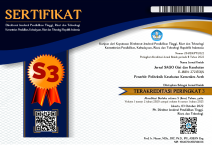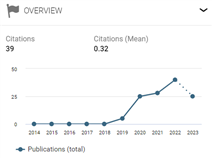Persepsi dan faktor penentu pemilihan produk pastry dan bakery sehat pada generasi Z: Studi kasus kuantitatif di Indonesia
DOI: 10.30867/gikes.v6i2.2306Abstract
Background: The trend of healthy eating continues to grow in Indonesia, particularly among Gen-Z, including pastry and bakery products. According to the Badan Pusat Statistik, the consumption of pastry and bakery products in Indonesia increased by 2,62% in 2023. However, the understanding of healthy products, such as pastry and bakery items, remains limited. This study aims to explore the perceptions and factors influencing the selection of these products among Gen-Z.
Objective: To understand the perceptions and reasons behind Gen-Z’s selection of healthy pastry and bakery products in Indonesia, as there is a concern that commercially available products may not meet health standards if consumed excessively.
Method: This study employs a quantitative approach, collecting data from 203 Gen-Z respondents across Indonesia. The measurement of perceptions regarding healthy products was conducted using a 10-question questionnaire, analyzed through frequency distribution. The reasons for product selection were measured using 23 questions based on the Food Choice Questionnaire, utilizing a Likert scale and factor analysis, following validity and reliability tests using SPSS.
Results: 51,72% of respondents have a "moderate" understanding of healthy products. The main selection factors—Health, Weight Control, and Sensory Appeal—account for 65,131% of the Total Variance Explained. For Gen-Z in Indonesia, the most preferred products are gluten-free, low-sugar, high-fiber, low-calorie, low-carb, low-fat, and great-tasting.
Conclusion: A new factor has emerged as a reason for selecting pastry and bakery products, which is a combination of Health, Weight Control, and Sensory Appeal, shaping Gen-Z’s perception of healthy pastry and bakery products in Indonesia.
Keywords
Full Text:
PDFReferences
Agustina, T., Susanti, E., & Rana, J. A. S. (2024). Sustainable consumption in Indonesia: Health awareness, lifestyle, and trust among Gen Z and Millennials. Environmental Economics, 15(1), 82–96. https://doi.org/10.21511/ee.15(1).2024.07
Allied Market Research. (2023). Organic Bread Market Size, Share, Competitive Landscape and Trend Analysis Report, by Type, by Application and, by Sales Channel: Global Opportunity Analysis and Industry Forecast, 2023-2032.
Ariestiningsih, E. S., & Has, D. F. S. (2024). Factors that cause unhealthy eating behavior in generation (gen) z of Indonesia: a Case Study. Formosa Journal of Applied Sciences, 3(2), 413–426. https://doi.org/10.55927/fjas.v3i2.8049
Daly, A. N., O’Sullivan, E. J., & Kearney, J. M. (2022). Considerations for health and food choice in adolescents. Proceedings of the Nutrition Society, 81(1), 75–86. https://doi.org/DOI: 10.1017/S0029665121003827
Faidul Jihad, F., Paradhiba, M., Musnadi Is, J., Duana, M., Sriwahyuni, S., & Oktaria, Y. (2024). Pengaruh media sosial terhadap preferensi makanan sehat dan bergizi pada remaja: studi di kalangan siswa SMA. In Journal of Healthcare Technology and Medicine (Vol. 10, Issue 1).
Fajarni, S. (2019). Eating out sebagai gaya hidup (studi kasus fenomena remaja Kota Banda Aceh di Restoran Canai Mamak KL). Aceh Anthropological Journal. https://ojs.unimal.ac.id/index.php/AAJ/article/view/2784
Fernandito, A. M., & Ritonga, R. M. (2023). Analisis pengaruh penerapan gaya hidup sehat terhadap minat mengkonsumsi makanan sehat pada Yellow Fit Kitchen. Jurnal Sosial Teknologi, 3(7), 613-619.
Field, A. (2024). Discovering statistics using IBM SPSS statistics. Sage publications limited.
Grunert, K. G., Hieke, S., & Wills, J. (2014). Sustainability labels on food products: Consumer motivation, understanding and use. Food Policy, 44, 177–189. https://doi.org/10.1016/j.foodpol.2013.12.001
Kern, D. M., Auchnicloss, A. H., Stehr, M. F., Diez Roux, A. V., Moore, L. V., Kanter, G. P., & Robinson, L. F. (2017). Neighborhood prices of healthier and unhealthier foods and associations with diet quality: Evidence from the multi-ethnic study of atherosclerosis. International Journal of Environmental Research and Public Health, 14(11).
https://doi.org/10.3390/ijerph14111394
Kunz, S., Pivecka, N., Dietachmair, C., & Florack, A. (2024). Seeing is misbelieving: Consumers wrongly believe that unhealthy food tastes better when there is more of it. Appetite, 197, 107295. https://doi.org/10.1016/J.APPET.2024.107295
Latief, R. (2024). Analisis dampak perilaku fear of missing out (FoMO) di kalangan pengguna media sosial. Jurnal Al-Irsyad Al-Nafs, 11(1), 31-46.
Lestari, N. S. (2020). Roti Gambang, acculturation bread from Betawi. Journal of Indonesian Tourism, Hospitality and Recreation, 3(1), 40-48.
Luca, L., Burlea, S. L., Chirosca, A.-C., Marin, I. M., Ciubara, A. B., & Ciubara, A. (2020). The FOMO syndrome and the perception of personal needs in contemporary society. Brain. Broad Research In Artificial Intelligence And Neuroscience, 11(1Sup1), 38–46. https://doi.org/10.18662/brain/11.1sup1/27
Magalhães, P., Vilas, C., Pereira, B., Silva, C., Oliveira, H., Aguiar, C., & Rosário, P. (2022). Children’s perceived barriers to a healthy diet: The influence of child and community-related factors. International Journal of Environmental Research and Public Health, 19(4). https://doi.org/10.3390/ijerph19042069
Meixner, O., Malleier, M., & Haas, R. (2024). Towards sustainable eating habits of generation z: Perception of and willingness to pay for plant-based meat alternatives. Sustainability (Switzerland), 16(8). https://doi.org/10.3390/su16083414
Monsivais, P., Aggarwal, A., & Drewnowski, A. (2014). Time spent on home food preparation and indicators of healthy eating. American Journal of Preventive Medicine, 47(6), 796–802. https://doi.org/10.1016/J.AMEPRE.2014.07.033
Monterrosa, E. C., Frongillo, E. A., Drewnowski, A., de Pee, S., & Vandevijvere, S. (2020). Sociocultural influences on food choices and implications for sustainable healthy diets. Food and Nutrition Bulletin, 41(2_suppl), 59S-73S. https://doi.org/10.1177/0379572120975874
Neuman, W. Lawrence. (2014). Social research methods: qualitative and quantitative approaches. Pearson.
Rai, F. H., Jalal, K., Hussain, Z., Fatima Rai, A., Maqsud, M., & Khan, M. (2023). Awareness about nutrition facts on food labels and their influence on food selection among consumers. Pakistan Journal of Health Sciences, 185–189. https://doi.org/10.54393/pjhs.v4i04.442
Rizkitania, A., Auliyah, A., & Wani, Y. A. (2022). Faktor yang memengaruhi keputusan pembelian konsumen terhadap katering sehat. National Nutrition Journal/Media Gizi Indonesia, 17(2).
Román, S., Sánchez-Siles, L. M., & Siegrist, M. (2017). The importance of food naturalness for consumers: Results of a systematic review. Trends in Food Science & Technology, 67, 44–57. https://doi.org/10.1016/J.TIFS.2017.06.010
Salamah, U. (2021). Halal certification guarantee for food and medicine products (human rights perspective). International Journal of Halal System and Sustainability (InJHSS), 1(1). https://doi.org/10.33096/injhss.v1i1.197
Samson, L., & Buijzen, M. (2020). Craving healthy foods?! How sensory appeals increase appetitive motivational processing of healthy foods in adolescents. Media Psychology, 23(2), 159–183. https://doi.org/10.1080/15213269.2019.1584569
Savelli, E., & Murmura, F. (2023). The intention to consume healthy food among older Gen-Z: Examining antecedents and mediators. Food Quality and Preference, 105, 104788. https://doi.org/10.1016/J.FOODQUAL.2022.104788
Seguin, R., Connor, L., Nelson, M., Lacroix, A., & Eldridge, G. (2014). Understanding barriers and facilitators to healthy eating and active living in rural communities. Journal of Nutrition and Metabolism, 2014. https://doi.org/10.1155/2014/146502
Setiadi, I., & Ruswanti, E. (2024). Analisa kesadaran masyarakat terhadap polahidup sehat dengan makanan organik. Jurnal Pengabdian kepada Masyarakat Nusantara, 5(1), 20-25.
Statista Research Department. (2023). Gluten-free foods market in the U.S. - statistics & facts. https://www.statista.com/topics/2067/gluten-free-foods-market/?utm_source=chatgpt.com#topicOverview
Sudewo, V. R. P., Suprehatin, S., & Utami, A. D. (2023). Understanding studies on consumers’ food choices using food choice questionnaire: A scoping review and bibliometric analysis (ScoRBA). In Agraris (Vol. 9, Issue 2, pp. 238–257). Department of Agribusiness, Universitas Muhammadiyah Yogyakarta. https://doi.org/10.18196/agraris.v9i2.170
Veenhoven, R. (2017). Measures of happiness: Which to choose?. In Metrics of subjective well-being: Limits and improvements (pp. 65-84). Springer, Cham.
Wahl, D. R., Villinger, K., König, L. M., Ziesemer, K., Schupp, H. T., & Renner, B. (2017). Healthy food choices are happy food choices: Evidence from a real life sample using smartphone based assessments. Scientific Reports, 7(1), 17069. https://doi.org/10.1038/s41598-017-17262-9
Widyasari, S., Soliha, E., & Santoso, I. H. (2021). Fomsumerism: Mengembangkan perilaku conformity consumption dengan memanfaatkan fear of missing out konsumen. Jurnal Ilmiah Bisnis Dan Ekonomi Asia, 15(2), 159-171.
Zorbas, C., Browne, J., Chung, A., Peeters, A., Booth, S., Pollard, C., Allender, S., Isaacs, A., Hawkes, C., & Backholer, K. (2023). Shifting the social determinants of food insecurity during the COVID-19 pandemic: the Australian experience. Food Security, 15(1), 151–170. https://doi.org/10.1007/s12571-022-01318-4
Refbacks
- There are currently no refbacks.















